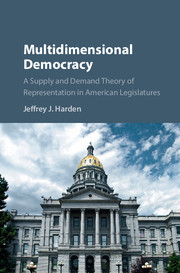Book contents
- Frontmatter
- Dedication
- Contents
- List of Figures
- List of Tables
- Acknowledgments
- 1 Responsiveness Beyond Roll Calls
- 2 A Supply and Demand Theory of Representation
- 3 Citizen Demand for the Dimensions of Representation
- 4 The Determinants of Legislators' Representational Priorities
- 5 Legislative Websites and the Dimensions of Representation
- 6 Unifying the Dimensions of Representation
- Appendix A Appendix to Chapter 3
- Appendix B Appendix to Chapter 4
- Appendix C Appendix to Chapter 5
- References
- Index
6 - Unifying the Dimensions of Representation
Published online by Cambridge University Press: 05 November 2015
- Frontmatter
- Dedication
- Contents
- List of Figures
- List of Tables
- Acknowledgments
- 1 Responsiveness Beyond Roll Calls
- 2 A Supply and Demand Theory of Representation
- 3 Citizen Demand for the Dimensions of Representation
- 4 The Determinants of Legislators' Representational Priorities
- 5 Legislative Websites and the Dimensions of Representation
- 6 Unifying the Dimensions of Representation
- Appendix A Appendix to Chapter 3
- Appendix B Appendix to Chapter 4
- Appendix C Appendix to Chapter 5
- References
- Index
Summary
Instead of viewing the various aspects of his job as distinct, Kevin Lundberg of Colorado's 15th Senate District looks for ways to combine them. For example, he uses service requests as inspiration for policy proposals: “Any time I work on an individual issue with a constituent I am looking for ways to put this experience into policy that can benefit the entire state.” One notable example occurred when Sen. Lundberg first ran for office in 1998. A new road proposed by the state adversely affected home values for several constituents who lived in the area near Berthoud, Colorado. Ultimately, he was not able to help those particular residents. However, when Sen. Lundberg got into office, he sponsored a bill to make eminent domain procedures more fair. Since then, he has defended private property rights very carefully because of that experience.
North Carolina state senator Bill Cook had a similar experience when he was in the state's House of Representatives. A constituent listed his wife as his state pension beneficiary, but she passed away before him. Years later, the constituent remarried and tried to list his new spouse as his beneficiary, but the state denied his request. After a prolonged struggle, he went to Cook for help. Cook worked hard to make sure that the problem was resolved not just in that instance, but through the law. In addition to helping that constituent, he also passed legislation designed to make the process more straightforward for all North Carolinians.
In both cases, these legislators coordinated multiple dimensions of representation to help their constituents. While the job of a legislator has many diverse elements, these examples show that they are all connected as means of “acting in the interest of the represented” (Pitkin, 1967, 209).
One potential problem in studying representation is that the concept can be both too broad and too narrow to enable a satisfactory understanding. On one hand, scholars have divided and categorized it in so many different ways that it is difficult to make sense of any true meaning.
- Type
- Chapter
- Information
- Multidimensional DemocracyA Supply and Demand Theory of Representation in American Legislatures, pp. 132 - 148Publisher: Cambridge University PressPrint publication year: 2015

